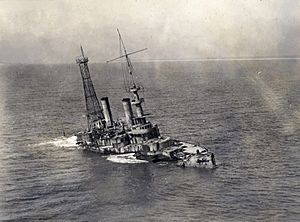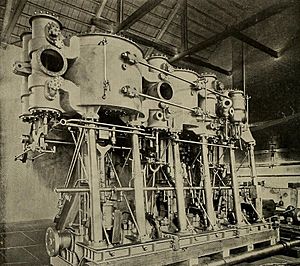USS Massachusetts (BB-2) facts for kids

Massachusetts in 1901
|
|
Quick facts for kids History |
|
|---|---|
| Name | Massachusetts |
| Namesake | Commonwealth of Massachusetts |
| Ordered | 30 June 1890 |
| Builder | William Cramp & Sons, Philadelphia, Pennsylvania |
| Yard number | 271 |
| Laid down | 25 June 1891 |
| Launched | 10 June 1893 |
| Sponsored by | Leila Herbert |
| Commissioned | 10 June 1896 |
| Decommissioned | 8 January 1906 |
| Recommissioned | 2 May 1910 |
| Decommissioned | 23 May 1914 |
| Recommissioned | 9 June 1917 |
| Renamed | Coast Battleship Number 2 29 March 1919 |
| Decommissioned | 31 March 1919 |
| Stricken | 22 November 1920 |
| Identification | Hull symbol: BB-2 |
| Fate | Scuttled, 6 January 1921 |
| Status | Artificial reef and diving site |
| General characteristics | |
| Class and type | Indiana-class pre-dreadnought battleship |
| Displacement | 10,288 long tons (10,453 t) standard |
| Length | 350 ft 11 in (107.0 m) |
| Beam | 69 ft 3 in (21.1 m) |
| Draft | 27 ft (8.2 m) |
| Installed power |
|
| Propulsion |
|
| Speed | 15 kn (28 km/h; 17 mph) (design) |
| Range | 4,900 nmi (9,100 km; 5,600 mi) |
| Complement | 473 officers and men |
| Armament |
|
| Armor | |
|
USS Massachusetts (BB-2)
|
|
| Lua error in Module:Location_map at line 420: attempt to index field 'wikibase' (a nil value). | |
| Location | Escambia County, Florida, US |
| Nearest city | Pensacola, Florida, US |
| Area | c. 1 acre (0.40 ha) |
| NRHP reference No. | 01000528 |
| Added to NRHP | 31 May 2001 |
The USS Massachusetts (BB-2) was a powerful battleship of the United States Navy. She was the second ship in her class, known as the Indiana-class battleship class. Built in the 1890s, she was designed for defending the coast.
Even though she was smaller than some ships, Massachusetts had strong armor and big guns. Her design was special because it was one of the first to use an "intermediate battery" of guns. Because she was made for coastal defense, her decks weren't very safe in rough, open ocean waters.
Massachusetts played a role in the Spanish–American War. She was part of the Flying Squadron and helped blockade Cuban ports. She later served as a training ship for sailors, especially during World War I. After her service, she was sunk on purpose in 1921 to be used as a target for testing artillery. Today, her wreck is an artificial reef and a popular spot for divers off the coast of Florida. It's also a protected historical site.
| Top - 0-9 A B C D E F G H I J K L M N O P Q R S T U V W X Y Z |
Building a Battleship: The Massachusetts Story
The Massachusetts was built based on a special design from 1889. This design was for a battleship that could defend the coast. The original plan was very big, aiming for many battleships. However, the United States Congress only approved funding for three coastal defense battleships. These became the Massachusetts and her sister ships, Indiana and Oregon.
These ships were limited to coastal defense. They couldn't travel far because they were not built for long journeys. They also had a low freeboard, meaning their decks were close to the water. This made them less stable in big ocean waves. But, they were very well-armed and armored for their size.
Construction and Launch
Building the Massachusetts was approved on June 30, 1890. The company William Cramp & Sons in Philadelphia won the contract to build her. The cost was about $3,020,000, not including the guns and armor. The total cost ended up being around $6,000,000.
The contract said the ship should be built in three years. But, there were delays in getting the armor plates and guns. Her keel (the main bottom part of the ship) was laid down on June 25, 1891. She was launched two years later, on June 10, 1893. Thousands of people watched the launching ceremony. Her first tests at sea happened in March 1896, and official tests a month later.
Massachusetts at Sea: Early Years
Massachusetts officially joined the Navy on June 10, 1896. Captain Frederick Rodgers was her first commander. She went on her first training trip between August and November 1896. After that, she had some work done at the New York Navy Yard.
In February 1897, she sailed to Charleston, South Carolina. In May, she visited Boston, where a big celebration was held for her. For the next ten months, she trained with the North Atlantic Squadron. She practiced off the coast of Florida and visited many ports on the American east coast. On March 27, 1898, she was ordered to Hampton Roads, Virginia. She joined the Flying Squadron to help blockade Cuba.
Serving in the Spanish–American War
When the Spanish–American War began, the Flying Squadron sailed to Key West, Florida. There, they planned how to find the Spanish fleet. The Massachusetts and her squadron were sent to Cienfuegos, Cuba, to search for enemy ships. They spent several days checking the harbor.
After confirming the Spanish ships were not there, the squadron went to Santiago de Cuba. This was another large port on Cuba's southern coast. They arrived on May 29. They saw the Spanish cruiser Spanish cruiser Cristóbal Colón from outside the harbor. This confirmed the Spanish fleet was inside. The squadron then blockaded the harbor.
Missing the Big Battle
For about a month, Massachusetts helped blockade Santiago de Cuba. She sometimes fired at the forts in the harbor. On the night of July 2–3, she left the blockade. She went to Guantánamo Bay, Cuba, to get more coal. Because of this, she missed the big Battle of Santiago de Cuba on July 3. In that battle, the Spanish fleet tried to escape but was completely destroyed.
The next day, Massachusetts returned to Santiago de Cuba. She and Texas fired at a Spanish ship, Spanish cruiser Reina Mercedes. The Spanish were sinking it to block the harbor entrance. After this, Massachusetts went to Puerto Rico to help with the American occupation. She then sailed back to New York, arriving on August 20.
Life After the War
After a quick repair, Massachusetts had some bad luck. On December 10, 1898, she hit Diamond Reef while leaving New York Harbor. Five of her front sections filled with water. She had to go back for repairs, which took about three months.
For a year, Massachusetts served with the North Atlantic Squadron. She visited many cities along the Atlantic coast. In May 1900, she was put into reserve. This was because the Navy needed officers for newer ships. But she was reactivated a month later to see how fast this could be done. She then rejoined the North Atlantic Squadron.
Accidents and Upgrades
In March 1901, the battleship ran aground again in Pensacola, Florida. But she was able to continue her journey. A more serious accident happened in January 1903 during target practice. An explosion in one of her 8-inch (203 mm) gun turrets killed nine crew members. These were the first deaths on a US battleship since the sinking of Maine in 1898.
Another accident happened in August 1903. Massachusetts hit a rock in Frenchman Bay, Maine. The ship was badly damaged and needed drydock repairs. In December 1904, three more men died and several were burned. This happened when a broken part caused steam to fill the boiler room.
On January 8, 1906, the battleship was taken out of service. Her crew moved to her sister ship Indiana. Massachusetts then received upgrades. These included new guns, new boilers, and other improvements.
Training and Reserve Duty
On May 2, 1910, Massachusetts was put back into service. She was used for annual summer cruises for Naval Academy midshipmen (students training to be officers). Even with her upgrades, she was considered old and not very useful for defense.
She was not used much, except for these summer cruises. In 1912, she was moved to the Atlantic Reserve Fleet. After a short trip to New York in October 1912 for a special review of Navy ships, she returned to Philadelphia. She stayed there until she was taken out of service again on May 23, 1914.
Massachusetts in World War I

When the United States joined World War I, Massachusetts was put back into service one last time. This happened on June 9, 1917. She was used to train Naval Reserve gun crews. They practiced firing guns in Block Island Sound.
From May 1918 until the end of World War I, she was used as a target ship. She helped train gun crews with heavy artillery practice near Chesapeake Bay. Massachusetts returned to Philadelphia on February 16, 1919. She was taken out of service for good on March 31, 1919. Two days before, she was renamed "Coast Battleship Number 2." This was so her original name could be used for a new battleship, Massachusetts (BB-54). However, this new ship was never finished. The name was later used for Massachusetts (BB-59), which fought in World War II and is now a museum ship.
The Final Resting Place: Scuttling and Reef
Massachusetts was removed from the Navy's list of ships on November 22, 1920. She was then given to the United States Department of War. They used her as a target ship for testing new artillery.
She was sunk on purpose (called scuttled) in shallow water in the Gulf of Mexico. This happened off Pensacola, Florida, on January 6, 1921. She was then bombarded by guns from Fort Pickens and by railway artillery.
On February 20, 1925, the Department of War returned her wreck to the US Navy. The Navy tried to sell her for scrap metal, but no one offered enough money. Another attempt to sell her was made in 1956, but the State of Florida stopped it.
Eventually, the Supreme Court of Florida declared Massachusetts the property of the State of Florida. On June 10, 1993, exactly 100 years after her launch, the wreck became the fourth Florida Underwater Archaeological Preserve. In 2001, the wreck was also added to the National Register of Historic Places. Today, it is an important artificial reef and a popular spot for diving. The front part of Massachusetts (her figurehead) is on display at Dahlgren Hall in Annapolis, Maryland.
Images for kids
See also
 In Spanish: USS Massachusetts (BB-2) para niños
In Spanish: USS Massachusetts (BB-2) para niños











